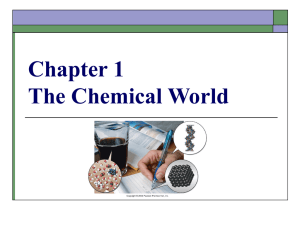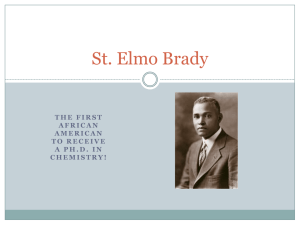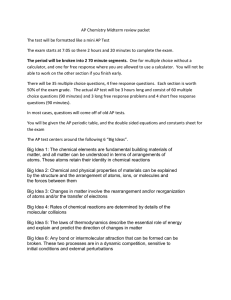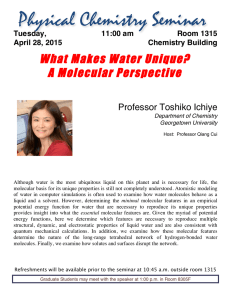Chapter 1: Chemistry and the Atomic/Molecular View of Matter
advertisement
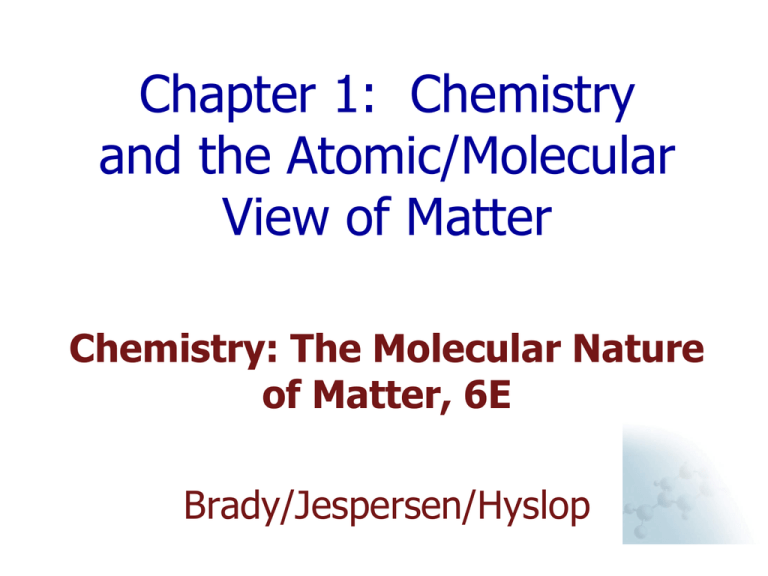
Chapter 1: Chemistry and the Atomic/Molecular View of Matter Chemistry: The Molecular Nature of Matter, 6E Brady/Jespersen/Hyslop 1.2- Scientific Method Approach to gathering information & formulating explanations. Scientists perform experiments in laboratories under controlled conditions 1. Make observations/collect data 2. Law or Scientific Law 3. Hypothesis 4. Theory Brady/Jespersen/Hyslop Chemistry: The Molecular Nature of Matter, 6E 2 Atomic Theory Most significant theoretical model of nature Atoms Tiny submicroscopic particles Make up all chemical substances Make up everything in Macroscopic world Smallest particle that has all properties of given element Composed of: Electrons Neutrons Protons Brady/Jespersen/Hyslop Chemistry: The Molecular Nature of Matter, 6E 3 1.3- Matter & Its Classifications Matter Anything that has mass & occupies space Mass How much matter given object has Measure of object’s momentum, or resistance to change in motion Weight Force with which object is attracted by gravity Ex. Mass vs. Weight Astronaut on moon & on earth Weight on moon = 1/6 weight on earth Same mass regardless of location Brady/Jespersen/Hyslop Chemistry: The Molecular Nature of Matter, 6E 4 Matter Chemical Reactions Transformations that alter chemical compositions of substances Decomposition Chemical reaction where 1 substance broken down into 2 or more simpler substances Ex. Molten sodium chloride Brady/Jespersen/Hyslop Electric current Sodium metal Na + chlorine gas Cl2 Chemistry: The Molecular Nature of Matter, 6E 5 Elements Substances that can’t be decomposed into simpler materials by chemical reactions Substances composed of only 1 type of atom H2 , O2 , Cl2 , Br2 , Na , Ca , Fe More complex substances composed of elements in various combinations diamond = carbon Brady/Jespersen/Hyslop gold Chemistry: The Molecular Nature of Matter, 6E sulfur 6 Chemical Symbols for Elements Chemical Symbol One or two letter symbol for each element name First letter capitalized, second letter lower case Ex. C = carbon Ca = calcium Br = bromine Cl = chlorine S = sulfur Ar = argon H = hydrogen O = oxygen Used to represent elements in chemical formulas Ex. Water = H2O Carbon dioxide = CO2 Most based on English name Some based on Latin or German names Brady/Jespersen/Hyslop Chemistry: The Molecular Nature of Matter, 6E 7 Chemical Symbols English Name Chemical Symbol Sodium Na Potassium K Iron Fe Copper Cu Latin Name Natrium Kalium Ferrum Cuprum Silver Gold Mercury Antimony Tin Ag Au Hg Sb Sn Argentum Aurum Hydrargyrum Stibium Stannium Lead Tungsten Pb W Plumbum Wolfram (German) Brady/Jespersen/Hyslop Chemistry: The Molecular Nature of Matter, 6E 8 Compound Formed from 2 or more atoms of different elements Always combined in same fixed ratios by mass Can be broken down into elements by some chemical changes Ex. Water decomposed to elemental hydrogen & oxygen Mass of oxygen = 8 × mass of hydrogen Brady/Jespersen/Hyslop Chemistry: The Molecular Nature of Matter, 6E 9 Pure Substance vs. Mixture Pure substances Elements and compounds / H2O, Na, N2, … Composition always same regardless of source Mixture Can have variable compositions Made up of two or more substances Ex. CO2 in water—varying amounts of “fizz” in soda 2 broad categories of mixtures: Heterogeneous Mixtures Homogeneous Mixtures Brady/Jespersen/Hyslop Chemistry: The Molecular Nature of Matter, 6E 10 Homogeneous Mixtures Same properties throughout sample Solution Thoroughly stirred homogeneous mixture Ex. Liquid solution Sugar in water Salt in water Gas solution Air Contains nitrogen, oxygen, carbon dioxide & other gases Other examples - Flour Milk powder Potable water Gasoline Solid solution US 5¢ coin – Metal Alloy Contains copper & nickel metals Brady/Jespersen/Hyslop Chemistry: The Molecular Nature of Matter, 6E 11 Heterogeneous Mixtures 2 or more regions of different properties Solution with multiple phases Separate layers Ex. Salad dressing Oil & vinegar Ice & water Same composition 2 different physical states Ether and water Soil Brady/Jespersen/Hyslop Chemistry: The Molecular Nature of Matter, 6E 12 Physical Change No new substances formed Substance may change state or the proportions Ex. Ice melting or water freezing Sugar or salt dissolving Melting of metals Condensation of vapor or evaporation of water Stirring iron filings & sulfur together Brady/Jespersen/Hyslop Chemistry: The Molecular Nature of Matter, 6E 13 Chemical Change or Chemical Reaction Formation of new substance or compound Involves changing chemical makeup of substances New substance has different physical properties Can’t be separated by physical means Ex. Fool’s gold Compound containing sulfur & iron No longer has same physical properties of free elements Can’t be separated using magnet Brady/Jespersen/Hyslop Chemistry: The Molecular Nature of Matter, 6E 14 Learning Check: For each of the following, determine if it represents a Chemical or Physical Change: Chemical Physical Magnesium burns when heated Magnesium metal tarnishes in air Magnesium metal melts at 922 K Grape Kool-aid lightens when water is added Brady/Jespersen/Hyslop Chemistry: The Molecular Nature of Matter, 6E X X X X 15 Classification of Matter Brady/Jespersen/Hyslop Chemistry: The Molecular Nature of Matter, 6E 16 Learning Check: Classification Hot Ice White Table Cocoa (H2O) Flour Salt (NaCl) Pure substance X X X X X Element Compound Molecule Heterogeneous Mixture X Homogeneous Mixture Brady/Jespersen/Hyslop Chemistry: The Molecular Nature of Matter, 6E X 17 Law of Conservation of Mass No detectable gain or loss of mass occurs in chemical reactions. Mass is conserved. Implication: Reactions involve reorganization of materials. Brady/Jespersen/Hyslop Chemistry: The Molecular Nature of Matter, 6E 18 Learning Check: Chemical Laws Magnesium burns in oxygen to form magnesium oxide. If 16.88 g of Mg are consumed and 28.00 g of MgO are produced, what mass of oxygen was consumed? 28.00 g – 16.88 g = 11.12g O Brady/Jespersen/Hyslop Chemistry: The Molecular Nature of Matter, 6E 19 Learning Check: Chemical Laws In a sample of MgO, there are 16.89 g Mg and 11.11 g O. What mass of O would there be in a sample that contains 2.00 g of Mg? 11.00 g O X 16.89 g Mg 2.00 g Mg 11.00 g O 2.00 g Mg X 16.89 g Mg X = 1.30 g O Brady/Jespersen/Hyslop Chemistry: The Molecular Nature of Matter, 6E 20 1.4- Dalton’s Atomic Theory John Dalton Developed underlying theory to explain Law of Conservation of Mass Law of Definite Proportions Reasoned that if atoms exist, they have certain properties Dalton’s Atomic Theory 1. Matter consists of tiny particles called atoms. Brady/Jespersen/Hyslop Chemistry: The Molecular Nature of Matter, 6E 21 Dalton’s Atomic Theory (cont) 2. Atoms are indestructible. In chemical reactions, atoms rearrange but do not break apart. 3. In any sample of a pure element, all atoms are identical in mass & other properties. 4. Atoms of different elements differ in mass & other properties. 5. In given compound, constituent atoms are always present in same fixed numerical ratio. Brady/Jespersen/Hyslop Chemistry: The Molecular Nature of Matter, 6E 22 1.5- Atoms and Molecules Chemical Formulas Atoms combine to form more complex substances Discrete particles Each composed of 2 or more atoms Ex. Molecular oxygen, O2 Carbon dioxide, CO2 Ammonia, NH3 Sucrose, C12H22O11 Brady/Jespersen/Hyslop Chemistry: The Molecular Nature of Matter, 6E 23 Chemical Formulas Specify composition of substance Chemical symbols Represent atoms of elements present Subscripts Given after chemical symbol Represents relative numbers of each type of atom Ex. Fe2O3 : iron & oxygen in 2:3 ratio Brady/Jespersen/Hyslop Chemistry: The Molecular Nature of Matter, 6E 24 Chemical Formulas Free Elements Element not combined with another in compounds Just use chemical symbol to represent Ex. Iron Fe Na Sodium Neon Ne Aluminum Al Diatomic Molecule Molecules composed of 2 atoms each Many elements found in nature Ex. Oxygen Hydrogen Brady/Jespersen/Hyslop O2 H2 Nitrogen Chlorine Chemistry: The Molecular Nature of Matter, 6E N2 Cl2 25 Depicting Molecules Want to show: Order in which atoms are attached to each other 3-dimensional shape of molecule Three ways of visualizing molecules: 1. Structural formula 2. Ball-and-Stick model 3. Space filling model Brady/Jespersen/Hyslop Chemistry: The Molecular Nature of Matter, 6E 26 1. Structural Formulas Use to show how atoms are attached Atoms represented by chemical symbols Chemical bonds attaching atoms indicated by lines H H O H H C H2O water H H CH4 methane Brady/Jespersen/Hyslop Chemistry: The Molecular Nature of Matter, 6E 27 3-D Representations of Molecules Hydrogen molecule, H2 Oxygen molecule, O2 Nitrogen molecule N2 Chlorine molecule, Cl2 Use touching spheres to indicate molecules Different colors indicate different elements Relative size of spheres reflects differing sizes of atoms Brady/Jespersen/Hyslop Chemistry: The Molecular Nature of Matter, 6E 28 2. “Ball-and-Stick” Model Spheres = atoms Sticks = bonds Methane, CH4 Brady/Jespersen/Hyslop Chloroform, CHCl3 Chemistry: The Molecular Nature of Matter, 6E 29 3. “Space-Filling” Model Shows relative sizes of atoms Shows how atoms take up space in molecule Methane CH4 Water H2O Chloroform, CHCl3 Brady/Jespersen/Hyslop Chemistry: The Molecular Nature of Matter, 6E 30 More Complicated Molecules Sometimes formulas contain parentheses How do we translate into a structure? Ex. Urea, CO(NH2)2 Expands to CON2H4 Atoms in parentheses appear twice Ball-and-stick model Brady/Jespersen/Hyslop Space-filling model Chemistry: The Molecular Nature of Matter, 6E 31 Hydrates Crystals that contain water molecules Ex. plaster: CaSO4∙2H2O calcium sulfate dihydrate Water is not tightly held Dehydration Removal of water by heating Remaining solid is anhydrous (without water) Blue = CuSO4 •5H2O Brady/Jespersen/Hyslop Chemistry: The Molecular Nature of Matter, 6E White = CuSO4 32 Counting Atoms 1. Subscript following chemical symbol indicates how many of that element are part of the formula No subscript implies a subscript of 1. 2. Quantity in parentheses is repeated a number of times equal to the subscript that follows. 3. Raised dot in formula indicates that the substance is a hydrate Number preceding H2O specifies how many water molecules are present. Brady/Jespersen/Hyslop Chemistry: The Molecular Nature of Matter, 6E 33 Counting Atoms Ex. 1 (CH3)3COH Subscript 3 means 3 CH3 groups So from(CH3)3, we get 3 × 1C = 3C 3 × 3H = 9H #C = 3C + 1C = 4 C #H = 9H + 1H = 10 H #O = 1 O Total # of atoms = 15 atoms Brady/Jespersen/Hyslop Chemistry: The Molecular Nature of Matter, 6E 34 Counting Atoms Ex. 2 CoCl2 · 6H2O The dot 6H2O means you multiple both H2 & O by 6 So there are: #H 6 × 2 = 12 H #O 6×1= 6O #Co 1 × 1 = 1 Co #Cl 2 × 1 = 2 Cl Total # of atoms = 21 atoms Brady/Jespersen/Hyslop Chemistry: The Molecular Nature of Matter, 6E 35 Your Turn! Count the number of each type of atom in the chemical formula given below a. b. c. d. e. Na2CO3 (NH4)2SO4 Mg3(PO4)2 CuSO4∙5H2O (C2H5)2N2H2 Brady/Jespersen/Hyslop a. b. c. d. e. ___Na, ___ 2 1 C, ___ 3 O ___N, ___H, ___S, ___O 2 8 1 4 ___Mg, ___P, ___O 3 2 8 ___Cu, ___S, ___O, ___H 9 10 1 1 ___C, ___H, ___N 12 4 2 Chemistry: The Molecular Nature of Matter, 6E 36 Dalton’s Atomic Theory We now have the tools to explain this theory & its consequences All molecules of compound are alike & contain atoms in same numerical ratio. Ex. Water, H2O Ratio of oxygen to hydrogen is 1 : 2 1 O atom : 2 H atoms in each molecule O weighs 16 times as much as H 1 H = 1 mass unit 1 O = 16 mass units Brady/Jespersen/Hyslop Chemistry: The Molecular Nature of Matter, 6E 37 Atoms in Fixed Ratios by Mass For water in general: mass O = 8 mass H Regardless of amount of water present Brady/Jespersen/Hyslop Chemistry: The Molecular Nature of Matter, 6E 38 Dalton’s Atomic Theory Successes: Explains Law of Conservation of Mass Chemical reactions correspond to rearranging atoms. Explains Law of Definite Proportions Given compound always has atoms of same elements in same ratios. Predicted Law of Multiple Proportions Not yet discovered Some elements combine to give 2 or more compounds Ex. SO2 & SO3 Brady/Jespersen/Hyslop Chemistry: The Molecular Nature of Matter, 6E 39 Using Law Of Multiple Proportions Mass S Mass O sulfur dioxide 32.06 g 32.00 g sulfur trioxide 32.06 g 48.00 g Use this data to prove law of multiple proportions Brady/Jespersen/Hyslop Chemistry: The Molecular Nature of Matter, 6E 40 Law of Multiple Proportions Compound Sample Mass of Mass of Size Sulfur Oxygen Sulfur dioxide 64.06 g Sulfur trioxide 80.06 g 32.06 g Ratio of Brady/Jespersen/Hyslop 32.06 g 32.06 g 48.00 g O in SO 3 48.00g 3 O in SO 2 36.00g 2 Chemistry: The Molecular Nature of Matter, 6E 41 1.6- Chemical Reactions When 1 or more substances react to form 1 or more new substances Ex. Reaction of methane, CH4, with oxygen, O2, to form carbon dioxide, CO2, & water, H2O. Reactants = CH4 & O2 Products = CO2 & H2O Brady/Jespersen/Hyslop Chemistry: The Molecular Nature of Matter, 6E 42 Chemical Equations Use chemical symbols & formulas to represent reactants & products. Reactants on left hand side Products on right hand side Arrow () means “reacts to yield” Ex. CH4 + 2O2 CO2 + 2H2O Coefficients Numbers in front of formulas Indicate how many of each type of molecule reacted or formed Equation reads “methane & oxygen react to yield carbon dioxide & water” Brady/Jespersen/Hyslop Chemistry: The Molecular Nature of Matter, 6E 43 Conservation of Mass in Reactions Mass can neither be created nor destroyed This means that there are the same number of each type of atom in reactants & in products of reaction If # of atoms same, then mass also same CH4 + 2O2 CO2 + 2H2O 4 H + 4O + C = 4 H + 4O + C Brady/Jespersen/Hyslop Chemistry: The Molecular Nature of Matter, 6E 44 Balanced Chemical Equation Ex. 2C4H10 + 13O2 8CO2 + 10H2O 4 C & 10 H per molecule Brady/Jespersen/Hyslop 2 O per molecule 1C&2O per molecule Chemistry: The Molecular Nature of Matter, 6E 2H&1O per molecule 45 Balanced Chemical Equation Ex. 2C4H10 + 13O2 8CO2 + 10H2O 2 molecules of C4H10 13 molecules 8 molecules of O2 of CO2 10 molecules of C4H10 Coefficients Number in front of formulas Indicate number of molecules of each type Adjusted so # of each type of atom is same on both sides of arrow Can change Brady/Jespersen/Hyslop Chemistry: The Molecular Nature of Matter, 6E 46 Balanced Chemical Equations How do you determine if an equation is balanced? Count atoms Same number of each type on both sides of equation? If yes, then balanced If no, then unbalanced Ex. 2C4H10 + 13O2 8CO2 + 10H2O Reactants Products 2×4 = 8 C 8×1 = 8 C 2×10 = 20 H 10×2 = 20 H 13×2 = 26 O (8×2)+(10×1)= 26 O Brady/Jespersen/Hyslop Chemistry: The Molecular Nature of Matter, 6E 47 Learning Check Fe(OH)3 + 2 HNO3 Fe(NO3)3 + 2 H2O Reactants Fe 1 Products 1 O 3 + (2×3) = 9 (3×3) + 2 = 11 H 3+2=5 (2×2) = 4 N 2 3 Not Balanced Only Fe has same number of atoms on either side of arrow. Brady/Jespersen/Hyslop Chemistry: The Molecular Nature of Matter, 6E 48 Your Turn! How many atoms of each element appear on each side of the arrow in the following equation? 4NH3 + 3O2 → 2N2 + 6H2O Reactants Products N (4 × 1) = 4 (2 × 2) = 4 O (3 × 2) = 6 (6 × 1) = 6 H (4 × 3) = 12 (6 × 2) = 12 Brady/Jespersen/Hyslop Chemistry: The Molecular Nature of Matter, 6E 49 * All Review Questions are required Focus On the following 1.5 1.11 1.12 1.14 1.29 1.32 1.33 1.41 1.48 1.53 Brady/Jespersen/Hyslop Chemistry: The Molecular Nature of Matter, 6E 50
